Motorola Moto G Review
by Brian Klug on December 18, 2013 2:00 PM EST- Posted in
- Smartphones
- Motorola
- Mobile
- *VA
- Cortex A7
- snapdragon 400
- Moto G
Display on mobile devices is one area where we’ve seen considerable improvement. Pixel density has gone up, contrast ratios have improved, and the emphasis on low power in a platform gated by its battery size means there’s always innovation happening. In the case of the Moto G, what we’re after should really be a display that looks visually appealing without any of the egregious issues that plague most midrange devices – poor viewing angles, low resolution, low contrast, dim displays.
On paper, the Moto G has what would probably have been a flagship display for a mobile device a year or two ago, it’s a 4.5-inch LCD with 1280x720 resolution and 326 PPI pixel density. The comparison point is the Moto X with a 4.7 inch AMOLED panel of the same 720p resolution and 312 PPI pixel density.
I’m pretty impressed with how the Moto G’s display looks. Subjectively, viewing angles are good, there aren’t any of the issues I normally attribute to non-flagship devices either with low pixel density or contrast that fails to please. There’s no light leakage at all from any of the corners.
One unfortunate thing about the Moto G I was sampled however is the presence of two small bubbles in the cover glass. I initially thought these were dust, but inspection with a microscope reveals they are in fact inhomogeneities in the cover glass.
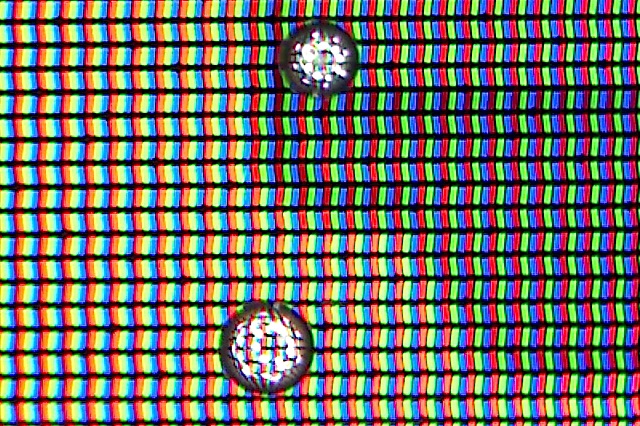
I’m not sure whether these kind of defects are within spec for the Moto G, but they’re distracting and visible on most solid colored UIs or views. I’ve never seen something like this on any handset I’ve reviewed to date.

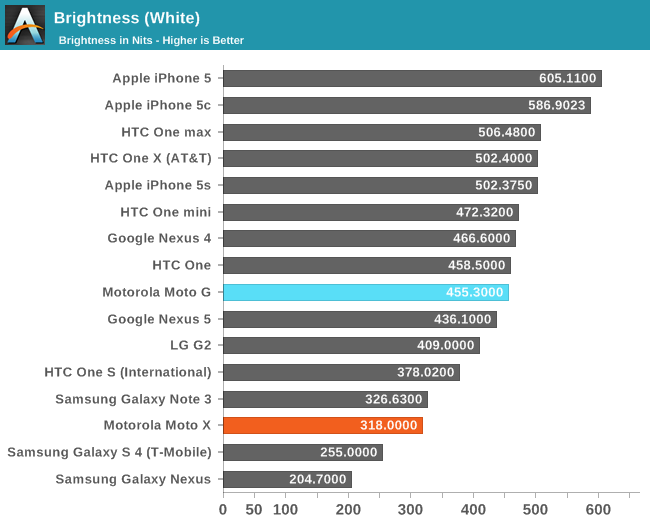

The Moto G goes plenty bright, at just over 455 nits, and delivers contrast numbers that are pretty darn good for the price point at just shy of 1200. Normally black levels are out of control on the lower end devices, I’m not sure if the Moto G uses an IPS panel, but suspect it does.
Upon inspection I immediately noticed that the Moto G display was very, very blue. To measure color accuracy we turn to the same combination of measures that we have used for a while now.
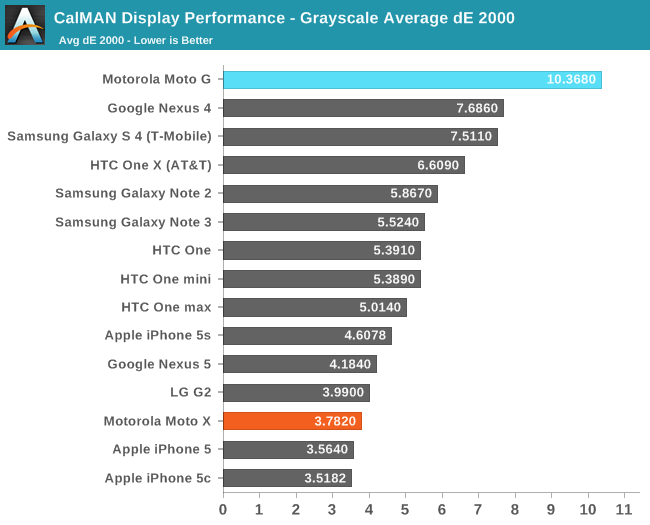
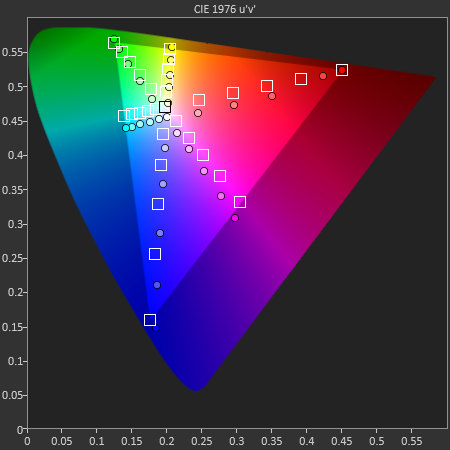



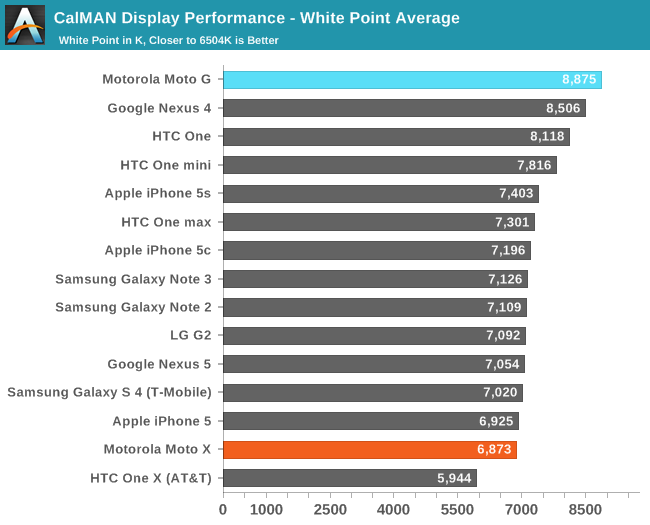
My comparison points are unfortunately primarily high end devices, which makes the Moto G look comparatively poor. The Moto G display tuning is indeed very blue with a white point of nearly 9000K, but I wouldn’t be surprised to learn this is a function of the backlight LEDs used or intrinsic properties of the panel.
Color calibration is something we’ve only just now started to see get taken seriously on the high end devices, if we can’t expect it to be a regular staple there, the midrange is obviously a lost cause. I wouldn’t fault the Moto G for not being very accurate, but it is something to be aware of as a sacrifice at this price point if you’re considering it over a high-end phone. On the flipside, the pixel density and contrast of the Moto G’s display seems excellent given the price, and I suspect the defects in my Moto G’s cover glass are specific to this unit.



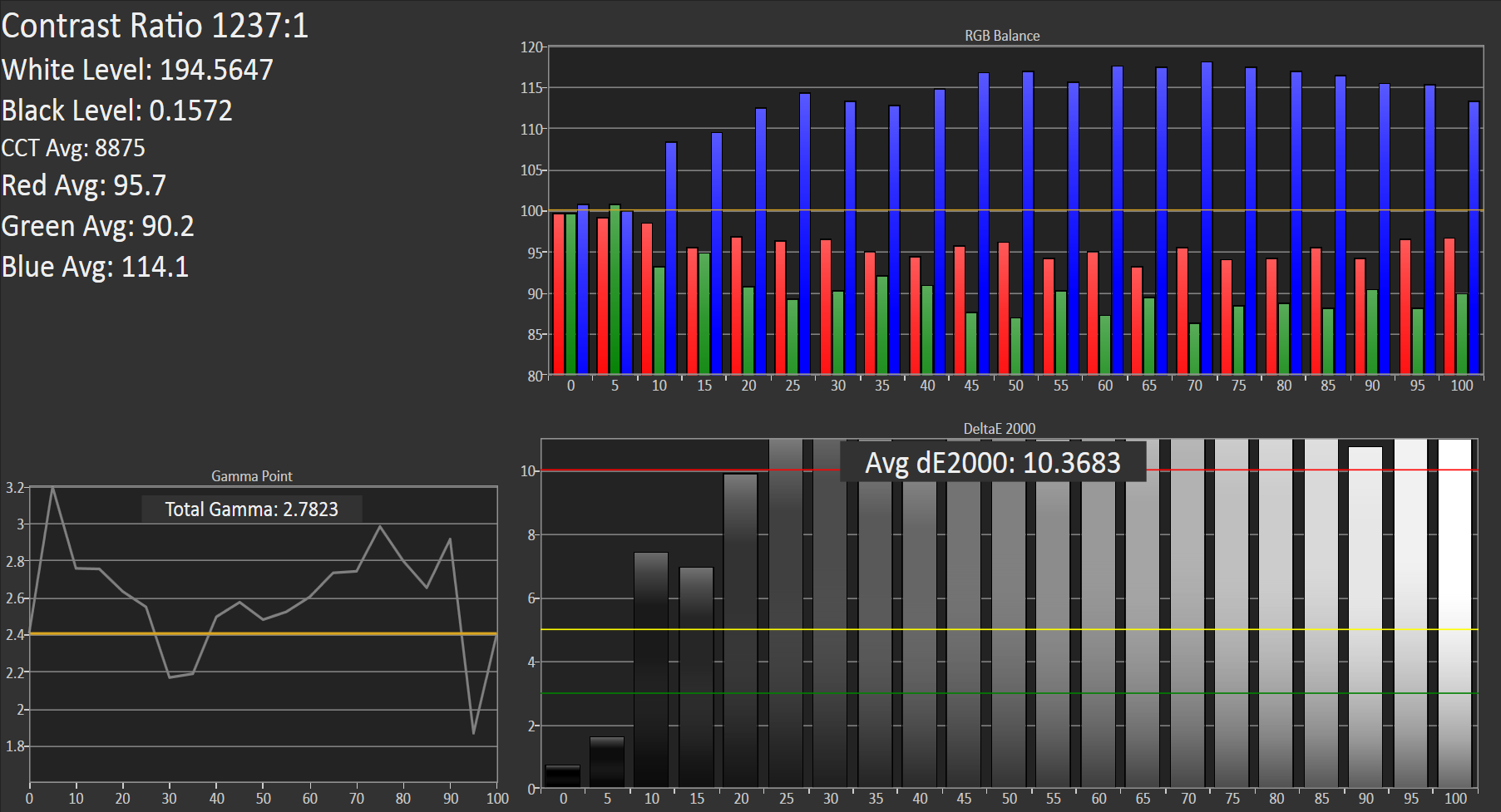








120 Comments
View All Comments
haukionkannel - Wednesday, December 18, 2013 - link
True, but this is not power user phone. The Noto X is for that purpose. For normal mister Smith this is very good phone indeed. But so is/are allso Lumia 52x phone(s), so comparison would be nice as someone above allready said.fic2 - Wednesday, December 18, 2013 - link
My girlfriend has a 521. It is a nice phone, but the HUGE problem is having to do a hard reset every time there is an upgrade. A hard reset looses all settings. And MS seems incapable of doing a backup that actually backs up everything. The stuff they do backup has to go to "the cloud" (to be datamined by them and the NSA). And when you do a restore it is a one-shot and can only be done over 3G since wireless isn't enabled at the time.Because of this I am thinking about getting her a Moto G.
skiboysteve - Saturday, December 21, 2013 - link
What are you talking about? WP updates are OTA incremental and never require a hard reset...shaduck007 - Saturday, January 4, 2014 - link
thanks for Mentioning the Lumia, it's 1/3 the price of the MOTO G.Thinking of what is the best value!!
Sam
sephirotic - Wednesday, February 5, 2014 - link
If this is not a power use phone then why add quad core, instead of a dual core processor, and a 720p screen? Witch is cheaper and more usefull, that or a SD card slot?grayson_carr - Wednesday, December 18, 2013 - link
Are power users interested in this phone as their main device? If 8 or 16GB was fine for the flagship Nexus 4 13 months ago, I think it's fine for a low cost phone now.grayson_carr - Wednesday, December 18, 2013 - link
Lets not forget, the average consumer still buys a 16GB iPhone or 16GB Galaxy S4 and doesn't put in a microSD card in the case of the GS4.fokka - Wednesday, December 18, 2013 - link
source? regarding the s4 i mean.flyingpants1 - Wednesday, December 18, 2013 - link
The average consumer doesn't actually use their phone for more than an hour or two a day, leaving it in sleep state 95% of the time and somehow assumes this means it has "good battery life".The average consumer does not store hours of movies on their phone, or watch movies on their phone at all.
The average consumer also can't see the difference between a 5mp camera and a 13mp camera.
The average consumer sees almost no benefit from 7mbit HSPA+ to 30mbit LTE.
The average consumer doesn't care about front speakers or waterproofing.
The average consumer doesn't use a wireless charger.
The average consumer CANNOT. SEE. The difference between a 540x960 display and a 1080p display.
The average consumer doesn't run more than a couple apps at the same time.
The average consumer doesn't care about read/write speeds of the NAND on their phone.
The average consumer doesn't know the difference between LCD and AMOLED.
Smartphones are ubiquitous now. Every grandma has a $0 iPhone that they don't know how to use. This doesn't mean we should stop making things better. For god's sake don't make us all suffer on behalf of your demented relatives.
apertotes - Wednesday, December 18, 2013 - link
it was not fine for nexus 4. And I explicitly said that it was not a poweruser scenario at all.